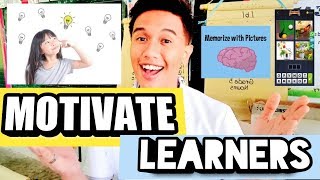It is critical to keep students interested and involved in their learning journey in today’s fast-paced and competitive society.
Motivation plays a vital role in a student’s academic success and overall personal development.
As an educator and mentor, it is my obligation to give them the tools and activities they need to be motivated.
In this post, I, NGschoolboard, will explore a comprehensive list of motivational activities for students in 2023.
These exercises are intended to motivate and inspire pupils to achieve their maximum potential.
Let’s go there!
See 15 Mind-Blowing Fun Activities for Students in the Classroom

1. Goal Setting Workshop
Setting goals is an essential skill for students to develop. Conducting a goal-setting workshop can empower students to identify their aspirations and create a roadmap to achieve them.
Encourage students to set SMART goals (specific, measurable, achievable, relevant, and time-bound) and guide them in breaking down their goals into actionable steps.
This activity helps students develop a growth mindset and provides a sense of purpose.
2. Guest Speaker Sessions
Inviting guest speakers from various fields can broaden students’ horizons and expose them to diverse career paths and life experiences.
These sessions can inspire students by showcasing real-world success stories and providing valuable insights.
Encourage students to interact with the guest speakers and ask questions.
This activity not only motivates students but also helps them connect their classroom learning to the real world.
3. Peer Recognition Program
Implementing a peer recognition program creates a positive and supportive learning environment.
Encourage students to acknowledge and appreciate their peers’ efforts and achievements.
This exercise develops a sense of community among kids and inspires them to strive for excellence.
Consider organizing monthly or quarterly award ceremonies to recognize outstanding student contributions.
4. Inspirational Video Clips
Visual media can have a powerful impact on student’s motivation.
Share inspirational video clips that highlight stories of resilience, determination, and success.
These videos can feature renowned personalities, historical events, or even ordinary individuals who have overcome significant challenges.
Discuss the key takeaways from each video and encourage students to reflect on their own aspirations.
5. Personal Development Workshops
Empowering students with life skills and personal development strategies can significantly enhance their motivation.
Conduct time management, effective communication, problem-solving, and critical thinking training.
Equip students with the necessary tools to navigate challenges and achieve their goals.
These workshops not only foster motivation but also lay the foundation for lifelong learning.
6. Career Exploration Days
Organize career exploration days where students can engage in interactive activities related to different professions.
Set up booths or stations representing various career paths, and allow students to explore hands-on activities and ask questions of professionals.
This activity encourages students to pursue their ambitions by helping them find their interests, hobbies, and prospective job alternatives.
7. Collaborative Projects
Assigning collaborative projects encourages teamwork, cooperation, and creativity among students.
Collaborative projects allow students to build on one another’s talents while also improving their interpersonal skills.
Encourage students to choose topics of interest and provide guidance throughout the project.
Celebrate the accomplishments and showcase the projects to the wider school community.
8. Mentoring Programs
Establish mentoring programs where older students or external mentors can guide and support younger students.
Mentoring relationships foster personal growth, boost self-confidence, and provide valuable guidance.
Pair students with mentors who share similar interests or career aspirations.
Regular mentor-mentee interactions can significantly enhance students’ motivation and provide them with invaluable advice.
9. Gamification of Learning
Incorporating gamification elements into the learning process can make education more enjoyable and engaging for students.
Introduce educational games, quizzes, and challenges that align with the curriculum.
Provide rewards, badges, or points to motivate students to progress and achieve higher levels.
Gamification creates a sense of achievement and encourages healthy competition among students.
10. Celebrating Milestones and Achievements
Acknowledging students’ milestones and achievements is crucial for maintaining their motivation.
Celebrate individual and collective successes by organizing recognition events, certificates of achievement, or honour rolls.
Publicly appreciate students’ hard work and dedication.
This practice motivates kids to establish new objectives and strive for greatness while also creating a good learning environment.
See the book that talks about Motivational activities Here.
See New Quick Games To Play in The Classroom
List Of Motivational Activities for Students
Setting the Stage: Creating a Motivating Environment
To create a motivating environment for kids, it is critical to create a pleasant and supportive setting in which students feel encouraged to learn and flourish.
Below are some key strategies for creating such an environment:
- Cultivating a Positive Classroom Atmosphere:
- Foster a sense of belonging and inclusivity among students.
- Encourage open communication and respect for diverse perspectives.
- Create a safe and welcoming physical space with inspiring visuals and displays.
- Establishing Clear Goals and Expectations:
- Clearly communicate learning objectives and expectations to students.
- Break down complex tasks into manageable steps for students to follow.
- Provide regular feedback and recognition to acknowledge students’ progress.
- Promoting a Growth Mindset:
- Emphasize the importance of effort, resilience, and embracing challenges.
- Encourage students to view failures as learning opportunities.
- Teach strategies to overcome obstacles and develop a growth mindset.
By setting the stage and creating a motivating environment, educators can lay the foundation for students’ engagement, enthusiasm, and self-motivation.
See How to Use Exam Timetable to Ace Your Exams
Individual Motivational Activities
Individual motivational activities encourage students’ self-reflection, self-motivation, creativity, and self-discovery.
These activities empower students to take ownership of their learning and personal growth.
Below are some effective individual motivational activities:
- Personal Reflection and Goal-Setting:
- Journaling for self-reflection: Encourage students to reflect on their thoughts, feelings, and experiences regularly.
- Creating vision boards: Have students visualize their goals and aspirations by creating visual collages.
- Setting SMART goals: Teach students to set Specific, Measurable, Attainable, Relevant, and Time-bound goals.
- Encouraging Self-Motivation:
- Developing a growth mindset: Help students adopt a belief in their ability to grow and improve through effort and perseverance.
- Practicing positive affirmations: Encourage students to affirm their strengths, abilities, and potential.
- Visualizing success: Guide students to imagine themselves achieving their goals and experiencing success.
- Harnessing Creativity:
- Engaging in artistic expressions: Encourage pupils to express themselves through art, whether it’s sketching, painting, or music.
- Participating in creative writing exercises: Inspire students to write stories, poems, or personal narratives to explore their creativity.
- Exploring innovative problem-solving activities: Present real-world problems to pupils and encourage them to think outside the box to find answers.
- Promoting Self-Discovery and Exploration:
- Personality and strengths assessments: Help students understand their unique personality traits and strengths.
- Exploring different career paths: Expose students to a variety of professions and industries to help them discover their interests and passions.
- Trying new hobbies and extracurricular activities: Encourage students to explore new activities outside their academic curriculum to broaden their horizons.
Individual motivating activities can help students build self-awareness, motivation, and a sense of purpose, leading to increased engagement and personal growth.
Collaborative Motivational Activities
Collaborative motivational activities aim to foster teamwork, cooperation, peer support, and social engagement among students.
These activities foster a sense of belonging, improve communication and problem-solving abilities, and boost motivation through teamwork.
Below are some engaging, collaborative motivational activities:
- Team-Building and Cooperation:
- Icebreaker activities for building relationships: Engage students in fun and interactive icebreaker games and activities to help them get to know each other better.
- Collaborative problem-solving challenges: Present students with group tasks or puzzles that require them to work together to find solutions.
- Organizing group projects and presentations: Assign students to work in teams on projects or presentations, fostering collaboration, division of tasks, and shared responsibility.
- Peer Support and Encouragement:
- Establishing study groups: Encourage students to join study groups so that they can support and assist one another in their academic endeavours.
- Creating a buddy system: Pair students up as study buddies or mentors to provide mutual support and motivation.
- Conducting peer mentoring programs: Implement programs where older students mentor younger ones, sharing experiences, knowledge, and guidance.
- Social Responsibility and Community Engagement:
- Volunteering for a cause: Engage students in community service or volunteer projects that align with their interests and values.
- Fundraising events and initiatives: Organize fundraising activities where students work collectively to raise funds for a charitable cause.
- Participating in community service projects: Encourage students to actively contribute to their local community through service initiatives, such as cleaning drives or organizing awareness campaigns.
By implementing these collaborative motivational activities, educators can foster a sense of teamwork, mutual support, and social responsibility among students.
These activities promote a positive classroom culture, enhance communication skills, and inspire students to make a difference together.
Technology-Driven Motivational Activities
Incorporating technology can bring a new level of engagement and excitement to motivational activities.
Technology-driven activities leverage digital tools, educational apps, and online platforms to enhance student motivation and participation.
Below are some technology-driven motivational activities:
- Gamification and Educational Apps:
- Using gamified learning platforms: Utilize educational platforms that gamify the learning experience, offering rewards, levels, and challenges to motivate students.
- Exploring educational apps for motivation: Introduce students to interactive and engaging educational apps that make learning enjoyable and immersive.
- Incorporating rewards and badges for achievements: Implement a system that rewards students with virtual badges or points for accomplishing learning milestones or demonstrating positive behaviors.
- Online Challenges and Competitions:
- Participating in coding challenges: Engage students in coding competitions or challenges to foster problem-solving skills and computational thinking.
- Engaging in online debates and discussions: Encourage students to participate in online forums or platforms where they can engage in intellectual discussions and debates.
- Joining virtual academic competitions: Motivate students to participate in virtual academic competitions or quizzes related to their subjects of interest.
- Virtual Field Trips and Guest Speakers:
- Exploring virtual tours and simulations: Take students on virtual field trips to museums, historical sites, or other educational locations, offering immersive learning experiences.
- Inviting guest speakers through video conferences: Arrange for guest speakers, experts, or professionals to speak to students through video conferences, providing insights and inspiration.
- Organizing webinars and online workshops: To introduce students to new ideas, skills, and possibilities, hold webinars or online workshops on a variety of topics.
By incorporating technology-driven motivational activities, educators can leverage the power of digital tools and platforms to enhance student engagement, curiosity, and motivation.
These activities make learning interactive, personalized, and relevant in today’s digital age.
Motivational Activities Beyond the Classroom
Motivational activities outside of the classroom allow students to explore and participate in experiences outside of their typical academic context.
These activities promote personal development, leadership, cultural knowledge, and a sense of community.
Below are some motivational activities beyond the classroom:
- Outdoor and Adventure Activities:
- Outdoor team-building exercises: Organize activities such as ropes courses, hiking, or camping trips that promote teamwork, trust, and problem-solving skills.
- Adventure-based learning programs: Engage children in adventure-based learning activities that inspire risk-taking, resilience, and personal growth, such as rock climbing or rafting.
- Nature exploration and environmental projects: Encourage students to connect with nature through activities like wildlife conservation, gardening, or environmental clean-up initiatives.
- Leadership and Empowerment Programs:
- Attending leadership workshops and seminars: Allow students to participate in workshops or seminars focusing on leadership development, self-motivation, and personal empowerment.
- Joining student organizations and clubs: Encourage students to join clubs or organizations that foster leadership skills, teamwork, and collaboration, such as student government or service clubs.
- Participating in leadership development camps: Enroll students in leadership camps or retreats where they can engage in leadership activities, team-building exercises, and personal growth experiences.
- Cultural and Artistic Experiences:
- Attending live performances and exhibitions: Take students to live performances, such as theatre plays, concerts, or art exhibitions, to expose them to different art forms and cultures.
- Exploring different cultures through events and festivals: Encourage students to participate in cultural events, festivals, or celebrations that celebrate diversity and broaden their cultural awareness.
- Showcasing talents through talent shows and art competitions: Organize talent shows, art competitions, or showcases where students can share their talents and creativity with their peers.
By engaging in motivational activities beyond the classroom, students have the opportunity to develop leadership skills, explore their interests, connect with nature, and appreciate diverse cultures.
These activities offer a well-rounded educational experience that extends beyond academic learning and promotes personal growth and a sense of purpose.
See How to Become a Certified Financial Analyst
Summary
Motivation is a key factor in student success, and incorporating motivational activities can significantly enhance students’ engagement, enthusiasm, and personal growth.
In this post, I have explored a comprehensive list of 100 motivational activities for students.
I began by discussing the importance of creating a motivating environment, including cultivating a positive classroom atmosphere and establishing clear goals and expectations.
I then moved on to individual motivating activities that emphasize self-reflection, motivation, creativity, and self-discovery.
These activities included personal reflection and goal-setting, encouraging a growth mindset, harnessing creativity, and promoting self-discovery and exploration.
Next, I explored collaborative motivational activities that foster teamwork, peer support, and social engagement.
These activities involved team-building and cooperation, peer mentoring, and community engagement.
I also discussed technology-driven motivational activities, which leverage digital tools, gamification, and online platforms to enhance student motivation and participation.
These activities included gamified learning platforms, online challenges and competitions, and virtual field trips and guest speakers.
Lastly, I explored motivational activities beyond the classroom, which provide students with experiences that foster personal growth, leadership skills, cultural awareness, and a sense of community.
These activities included outdoor and adventure activities, leadership and empowerment programs, and cultural and artistic experiences.
By incorporating these motivational activities, educators, parents, and mentors can create an inspiring and empowering environment that fuels students’ motivation, leading to academic success, personal development, and a lifelong love for learning.
Remember, motivation is the fuel that propels students forward on their educational journey.
I can inspire, engage, and encourage students to attain their full potential and thrive in their academic endeavours and beyond by incorporating these activities.
See 50 Debate Topics for Secondary School
Conclusion
Motivating students is an ongoing process that requires continuous effort and creativity.
By implementing the aforementioned motivational activities in the academic year 2023, I can create an environment where students feel inspired, engaged, and eager to learn.
Remember that each student is unique, therefore provide a choice of activities that cater to various interests and learning styles.
Let’s empower our students to become lifelong learners and confident individuals ready to make a positive impact in the world.
FAQs
Q1: Why are motivational activities important for students? Students’ intellectual and personal growth is greatly aided by motivational activities.
They increase student engagement, create a good learning atmosphere, encourage self-reflection and goal-setting, teach important skills like teamwork and problem-solving, and motivate students to realize their full potential.
Q2: How can I incorporate motivational activities into my classroom? To incorporate motivational activities into your classroom, you can start by creating a positive and supportive atmosphere, setting clear goals and expectations, and incorporating individual, collaborative, and technology-driven activities.
Utilize tools like educational apps, gamification, and online platforms to make learning interactive and engaging for students.
Q3: Can motivational activities be adapted for different age groups? Absolutely! Motivational activities can be adapted for different age groups.
The key is to consider the developmental needs, interests, and abilities of the students.
Tailor the activities to suit the age group, ensuring they are age-appropriate, challenging, and relevant to their stage of learning.
Q4: How do motivational activities benefit students beyond academics? Beyond academics, motivational activities help students develop personal growth, self-confidence, leadership abilities, cultural knowledge, and a feeling of community.
These activities allow children to explore their interests, acquire life skills, and interact with the world around them, preparing them for success in a variety of areas.
Q5: Can parents incorporate motivational activities at home? Yes, parents can incorporate motivational activities at home. Encourage self-reflection, set goals together, engage in creative activities, explore new hobbies, and participate in family projects.
Additionally, parents can support their child’s motivation by providing a nurturing and supportive environment, celebrating their achievements, and encouraging a growth mindset.
Q6: How do motivational activities contribute to student success? Motivational activities help students succeed by encouraging a positive attitude toward learning, increasing engagement and involvement, developing critical thinking and problem-solving skills, increasing self-confidence, and instilling a lifetime love of learning.
These factors collectively contribute to improved academic performance and overall student achievement.
Remember, motivational activities are a powerful tool to inspire and empower students.
Adapt and personalize these activities to your student’s individual needs and interests, and watch them blossom as motivated and enthusiastic learners.







Top 10 Best Engaging Google Classroom Games for Interactive Learning - NGschoolBoard
[…] See Motivational Activities for Students […]
Interactive Online Games for Students 2023 - NGschoolBoard
[…] See Motivational Activities for Students […]
Interactive Online Games for Students- Boost Learning and Engagement 2023 - NGschoolBoard
[…] See Motivational Activities for Students […]